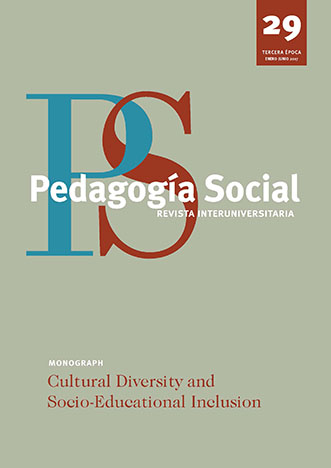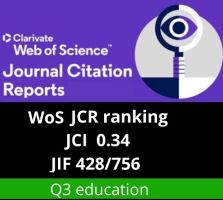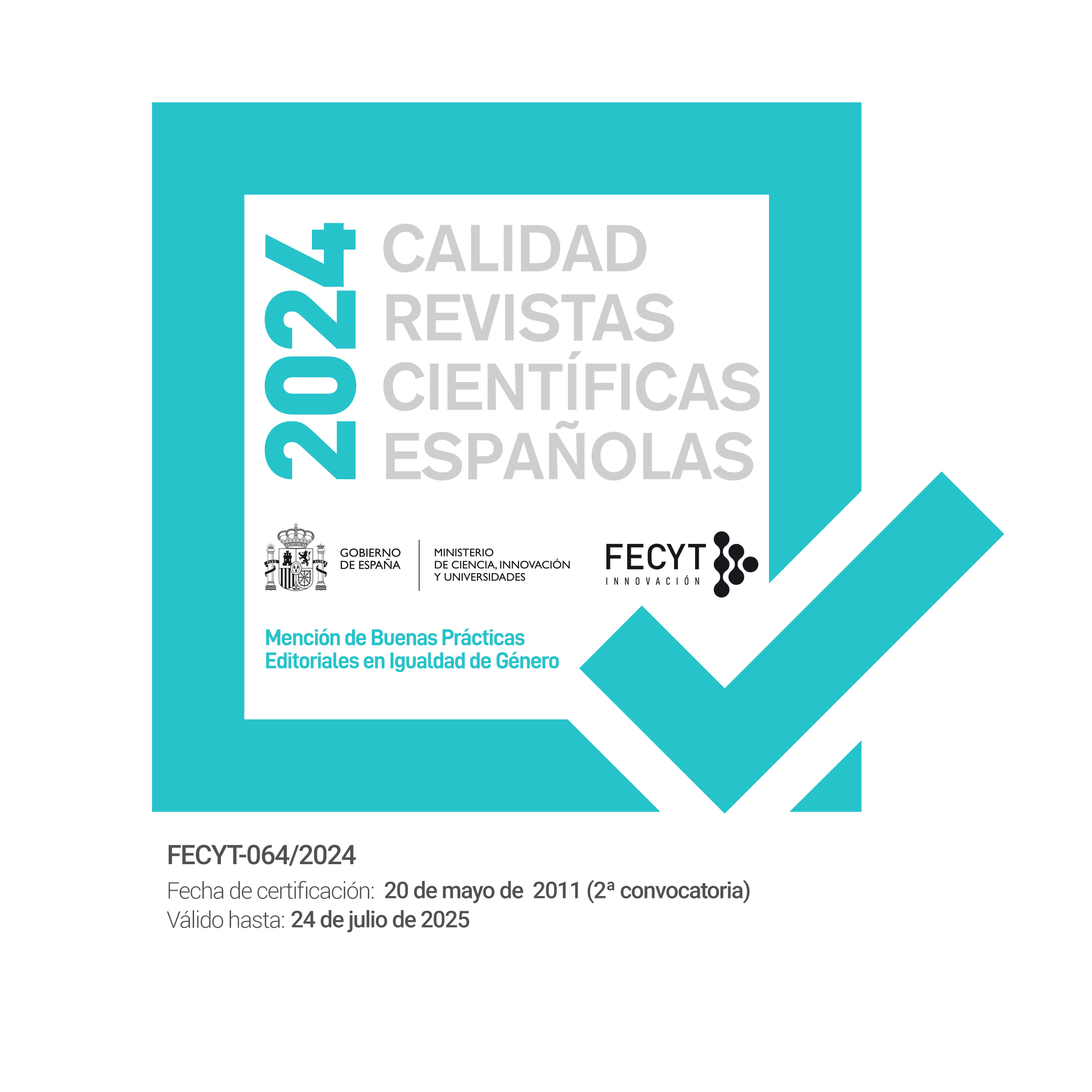Drivers and barriers to adolescent´s participation in community organizations: a case study
DOI:
https://doi.org/10.7179/PSRI_2017.29.11Keywords:
Community organizations, Participation, Adolescence, CitizenshipAbstract
This article presents some preliminary data of a research about a group of teenager´s participation (12-17 years-old) in a community project. It is based on a wider research project which, during two years (2013-15), has used an ethnographic approach to understand teenager´s daily experiences in that community project and the generated process through their interaction with peers and the educational team. The purpose of this article is to identify drivers and barriers that different agents perceive for participating in the community project. To this end, initial results are gathered in three discussion groups: adolescents who have a background on the organization (for at least 3 years) and high level of commitment related to a “projective type of participation” (Llena, Novella, Trilla, Noguera, Morata & Morell, 2015); their families and adult workers. Preliminary results of participant observation in the advisory group (22 hours) and assemblies (10 hours) of the community are also incorporated. Data analysis shows that there are three principal drivers to participate: the profile of the adolescents and their families, the relationships they established with the educational team and their awareness of learning. Regarding obstacles, there are other three aspects: participants’ lack of interest on the available opportunities, their stage of life and their expectations.
Downloads
References
Barnett, L. (2008). Predicting youth participation in extracurricular recreational activities: relationships with individual, parent, and family characteristics. Journal of Park and Recreation Administration, 26 (2), 28-60.
Benedicto, J. (2011). Construyendo la ciudadanía juvenil. Marco teórico para las políticas de juventud y ciudadanía. Retrieved from http://www.diba.cat/c/document Iibrary/get file ?uuid=flfcd66f-248d-4d81-a6cd606cce333a51&.
Benedicto, J. & Morán, M. (2007). Becoming a citizen. European Societies, 9 (4), 601-622.
Bilbao, M. (2008). Juventud vasca 2008. Vitoria-Gasteiz: Gobierno Vasco. Retrieved from:
Chaiklin, S. (2003). The zone of proximal development in Vygotsky’s analysis of learning and instruction. In A. Kozulin, B. Gindis, V. Ageyev. & S. Miller. (2003). Vygotsky’s educational theory and practice in cultural context. Cambridge: Cambridge University Press, pp. 39-64.
Checkoway, B. & Gutiérrez, L. (2009). Teoría y práctica de la participación juvenil y el cambio comunitario. Barcelona: GRAÓ.
Cremin, H., Warwick, P., Harrison, T. & Manson, C. (2009). Building voice, civic action and learning: What can we learn from young people living in socio-economically disadvantages communities? UK: University of Cambridge Retrie¬ved from: http://www.soc-for-ed-studies.org.uk/documents/nationalAward/building-voice.pdf.
Cusworth, L., Bradshaw, J., Coles, B., Keung, A. & Chzhen, Y. (2009). Understanding Social Exclusion Across the Life Course: Youth and Young Adulthood. London: Social Exclusion task Force, Cabinet Office.
Davies, I., Hampden-Thompson, G., Tsouroufli, M., Sundaram, V., Lord, P., Jeffes, J. & Bramley, G. (2012). Creating citi¬zenship communities. Journal of Social Science Education, 11 (3), 107-118.
De Certeau, M. (1999). La invención de lo cotidiano. México DF: Universidad Iberoamericana y Centro Francés de Es¬tudios Mexicanos y Centroamericanos.
De Weerd, M., Gemmeke, M., Rigter, J. & van Rij, C. (2005). Indicators for monitoring active citizenship and citizenship education. Bruselas: European Commission.
Ferreira, J., Pose Porto, H. & De Valenzuela Bandín, A. (2015). El ocio Cotidiano de los Estudiantes de Educación Secun¬daria en España. Pedagogía Social. Revista Interuniversitaria, 25, 25-49.
Finlay, S. (2010). Carving out meaningful spaces for youth participation and engagement in decision-making. Youth Studies Australia (29), 53-59.
Flanagan, C. & Levine, P. (2010). Civic Engagement and the transition to adulthood. The future of children, 20 (1), 159-179.
Flanagan, C., Jonsson, B., Botcheva, L., Csapo, B., Bowes, J., Macek, P., … Sheblanova, E. (1999). Adolescents and the “social contract”: Developmental Roots of Citizenship in seven countries. In M. Yates & J. Y. (ed.), Roots of civic identity. UK: Cambrige University Press, pp. 135-155.
Ginwright, P., Noguera, P. & Cammarota, J. (2006). Beyond resistance! Youth Activism and Community Change. Nueva York: Routledge: Tylor & Francis.
Hall, T., Coffey, A. & Williamson, H. (1999). Self, Space and Place: youth identities and citizenship. British Journal of So¬ciology of Education, 20 (4), 500-513.
Haste, H. (2010). Citizenship Education: a Critical Loos at a contested field. In J. T. L.R. Sherrod, Handbook of Research on Civic Engagement in Youth. Hoboken, NJ: John Wiley & Sons, Inc., pp. 161-188.
Hoskins, B. & Mascherini, M. (2009). Measuring Active Citizenship through the Development of a Composite Indicator. Soc Indic Res 90, 459-488.
Jennings, L., Parra-Medina, D., Hilfinger Messias, D. K. & McLoughlim, K. (2009). Hacia una teoría social crítica del em¬poderamiento de la juventud. En B. Checkoway & L. M. Gutiérrez, Teoría y práctica de la participación juvenil y el cambio comunitario. Barcelona: Graó, pp. 43-73.
Kirshner, B. (2008). Guided participation in three youth activism organizations: facilitation, apprenticeship and joint work. Journal of the Learning Sciences, 17 (1), 60-101.
Lozano, J. (2007). Jovenes educadores: tribus educadoras: entre los lugares y las redes. Barcelona: Graó.
Maiztegui-Oñate, C. & Fonseca Peso, J. (2014). Ciudadanía y participación en contextos de diversidad cultural: análisis desde la educación no formal. Interacçoes, 29, 37-59.
Manson, C., Cremin, H., Warwick, P. & Harrison, T. (2010). Building voice, civic action and learning: variation in levels of civic engagement amongst young people in areas of socio-economic disadvantages. Retrieved from http://enga¬ged.educ.cam.ac.uk/publications/Seminar%202%20Listening%20harder%20paper%20HC.pdf.
Morán, L. (2003). Aprendizajes y espacios de la ciudadanía para un análisis cultural de las prácticas sociopolíticas. ICONOS, pp. 31-43.
Morán, M., Iglesias, L., Vargas, J. & Rouco, F. (2012). Usos e imágenes del tiempo en el alumnado de Educación Secun¬daria Obligatoria (ESO): entre la escuela, la familia y la comunidad. Pedagogía Social. Revista Interuniversitaria, 20, 61-101.
Novella, A. (2008). Formas de participación Infantil. La concrección de un derecho. Educación Social. Revista de Inter¬vención Socioeducativa, 38, 77-93.
Novella, M., Llena, M., Trilla, J., Noguera, E., Morata, T., Agud, I. & Gómez, M. (2014). Participación Infantil y construcción de la ciudadanía. Barcelona: GRAÓ.
Observatorio Vasco de la Juventud (2012). Retratos de juventud 16 – Cultura democrática-. Retrieved from: http:// www.gazteaukera.euskadi.net/r58-7651x/es/contenidos/informacion/gazteen_argazkiak_bilduma/es_5561/adjuntos/ retratos16_c.pdf
Ortega, C., Lazcano, I. & Manuel, M. (2015). Espacios de ocio para jóvenes, de la monitorización a la autogestión. Peda¬gogía Social. Revista Interuniversitaria, 25, 69-88.
Pescarmona, I. (2014). Learning to participate through Complex Instruction. Intercultural Education, 25 (3), 187-196.
Rebollo, O. (2005). Introducción. En Participación y desarrollo comunitario en medio urbano. Construyendo ciudadanía 7. Madrid: IEPALA, pp. 9-16.
Rodriguez San Julián, A. (2012). Informe Juventud en España 2012. Madrid: NJUVE. Retrieved from: http://www.injuve. es/sites/default/files/2013/26/publicaciones/IJE2012_0.pdf
Ruiz Olabuénaga (2012). Metodología de la investigación cualitativa. Bilbao: Deusto.
Schwartz, S. & Suyemoto, K. (2013). Creating changer from the inside: youth development within a youth community organizing program. Journal of community psychology, 41 (3), 341-358.
Strobel, K. & Kirshner, B. (2008). Qualities that attract urban youth to after-school settings and promote continued participation. Teachers College Record, 110 (8), 1677-1705.
Strobel, K., Osberg, J. & McLaughlin. (2006). Participation in social change: shifting adolescents’ developmental pa¬thways. In P. Ginwinwright (2006). Beyond resistance! Youth Activism and community Change NY: Tylor & Francis Group, pp. 197-214.
Youniss, J. & Yates, M. (1997). Community service and social responsability in youth. Chicago: University of Chicago Press.
Downloads
Published
How to Cite
Issue
Section
License
Copyright (c) 2016 Pedagogía Social. Revista Interuniversitaria

This work is licensed under a Creative Commons Attribution-NonCommercial-ShareAlike 4.0 International License.
Copyright and right to archive
The published version of the articles can be self-archived by their authors in open access institutional and thematic repositories. However, Pedagogía Social. Revista Interuniversitaria must authorize partial or global reutilisation on new papers or publications.
Published papers must be cited including the title of the journal Pedagogía Social. Revista Interuniversitaria, issue, pages and year of publication
Ethical responsibilities
Pedagogía Social. Revista Interuniversitaria does not accept any material that has been previously published in other documents or publications. Authors are responsible for obtaining the required permissions for partial or global reproduction any material from other publications, and to correctly quote its origin.
Pedagogía Social. Revista Interuniversitaria is obliged to detect and report fraudulent practices.
Only those who have intellectually contribute to the development of the paper must appear as authors.
The journal expects authors to declare any commercial partnership that might entail a conflict of interest with respect to the submitted article.
Authors must mention in the article, preferably in the “methodology” section, that the procedures used during the samplings and controls have been made after getting informed consent.
The journal will not use any received contribution in a way other than the goals described in these guidelines.
Copyright Notice
© Pedagogía Social. Revista Interuniversitaria. Papers published in both the printed and online versions of this Journal are property of Pedagogia Social. Revista Interuniversitaria, being required to cite the source in any partial or total reproduction.
Unless otherwise stated, all content of this electronic journal is distributed under "Creative Commons Attribution-Non commercial 3.0 Spain" (CC-by-nc) license for use and distribution. The informative version and the legal text of this license is available here. This has to be expressly stated in this way when necessary.






